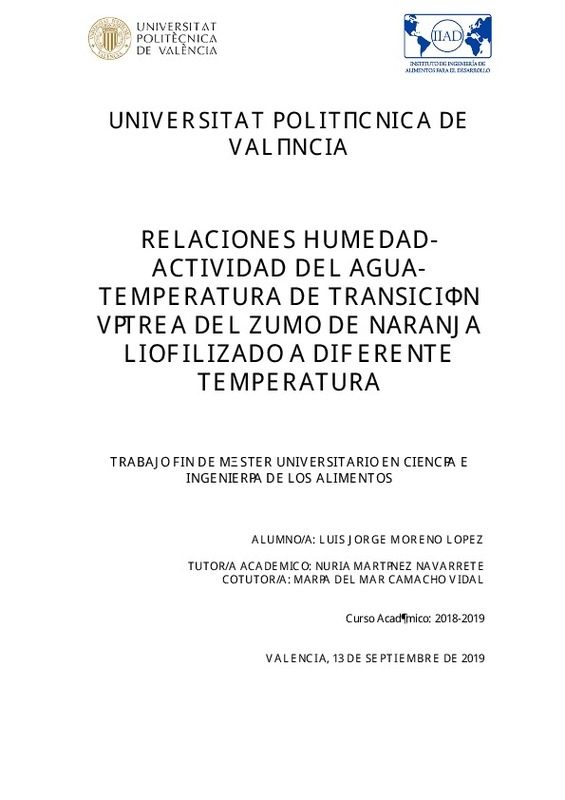JavaScript is disabled for your browser. Some features of this site may not work without it.
Buscar en RiuNet
Listar
Mi cuenta
Estadísticas
Ayuda RiuNet
Admin. UPV
Relaciones humedad-actividad del agua-temperatura de transmisión vítrea del zumo de naranja liofilizado a diferente temperatura
Mostrar el registro sencillo del ítem
Ficheros en el ítem
| dc.contributor.advisor | Martínez Navarrete, Nuria
|
es_ES |
| dc.contributor.advisor | Camacho Vidal, Mª Mar
|
es_ES |
| dc.contributor.author | Moreno López, Luis Jorge
|
es_ES |
| dc.date.accessioned | 2019-10-25T11:38:49Z | |
| dc.date.available | 2019-10-25T11:38:49Z | |
| dc.date.created | 2019-09-27 | |
| dc.date.issued | 2019-10-25 | es_ES |
| dc.identifier.uri | http://hdl.handle.net/10251/129538 | |
| dc.description.abstract | [ES] Las frutas son alimentos imprescindibles para una dieta sana y equilibrada. Esto se debe a su riqueza en compuestos bioactivos, que parecen aportar beneficios para la salud. Sin embargo, el consumo de fruta está en continuo descenso, lo que parece estar relacionado con su dificultad de almacenamiento y manejo. Una forma frecuente de consumo fruta es en forma de zumo y una manera de alargar la vida útil de un zumo natural es mediante su deshidratación. En esta forma, el producto podrá gozar de una adecuada estabilidad química y microbiológica. Sin embargo, cuando se trata de fruta procesada, es especialmente importante evitar la aplicación de altas temperaturas que dañen a los compuestos termolábiles responsables de sus beneficios saludables, además de evitar su oxidación. En este sentido, la liofilización parece un proceso idóneo para estos alimentos. No obstante, los productos de fruta deshidratados pueden presentar problemas de estabilidad física relacionados con su colapso estructural. Éste empieza a ocurrir a temperaturas por encima de su temperatura de transición vítrea (Tg), la cual depende de la humedad (xw) y actividad del agua (aw). A su vez, la humedad de un alimento varía dependiendo de la humedad relativa de su entorno. Por tanto, es imprescindible asegurar que, tanto durante el procesado como durante el almacenamiento, el producto no sobrepasa las condiciones Tg-xw-aw que aseguran su estabilidad física. Teniendo en cuenta lo anterior, el objetivo de este trabajo ha sido conocer la relación Tg-xw-aw de un zumo de naranja liofilizado, obtenido realizando el secado de producto tanto a temperatura ambiente como a 50 ºC. | es_ES |
| dc.description.abstract | [EN] Fruits are essential foods for a healthy and balanced diet. This is due to its richness in bioactive compounds, which seem to bring health benefits. However, the consumption of fruit is in continuous decline, which seems to be related to its difficulty of storage and handling. A frequent form of fruit consumption is in the form of juice and one way to extend the shelf life of a natural juice is by dehydration. In this way, the product can enjoy adequate 3 chemical and microbiological stability. However, when fruit is processed, it is especially important to avoid the application of high temperatures that damage the thermolabile compounds responsible of their health benefits, in addition to preventing their oxidation. In this sense, freeze-drying seems an adequate process for these foods. However, dehydrated fruit products can present physical stability problems related to their structural collapse. This begins to occur at temperatures above its glass transition temperature (Tg), which depends on the water content (xw) and water activity (aw). In turn, the water content of a food varies depending on the relative humidity of its surrounding. Therefore, it is essential to ensure that, both during processing and during storage, the product does not exceed the Tg-xw-aw conditions that ensure its physical stability. Considering the above, the objective of this work has been to know the Tg-xw-aw relationships of a freeze-dried orange juice, obtained by drying the product both at room temperature and at 50 °C. | es_ES |
| dc.format.extent | 13 | es_ES |
| dc.language | Español | es_ES |
| dc.publisher | Universitat Politècnica de València | es_ES |
| dc.rights | Reserva de todos los derechos | es_ES |
| dc.subject | Freeze drying | es_ES |
| dc.subject | Orange juice | es_ES |
| dc.subject | Water content | es_ES |
| dc.subject | Water activity | es_ES |
| dc.subject | Relative humidity | es_ES |
| dc.subject | Glass transition temperature | es_ES |
| dc.subject | Liofilización | es_ES |
| dc.subject | Zumo de naranja | es_ES |
| dc.subject | Contenido de agua | es_ES |
| dc.subject | Actividad del agua | es_ES |
| dc.subject | Humedad relativa | es_ES |
| dc.subject | Temperatura de transición vítrea | es_ES |
| dc.subject.classification | TECNOLOGIA DE ALIMENTOS | es_ES |
| dc.subject.other | Máster Universitario en Ciencia e Ingeniería de los Alimentos-Màster Universitari en Ciència i Enginyeria Dels Aliments | es_ES |
| dc.title | Relaciones humedad-actividad del agua-temperatura de transmisión vítrea del zumo de naranja liofilizado a diferente temperatura | es_ES |
| dc.type | Tesis de máster | es_ES |
| dc.rights.accessRights | Abierto | es_ES |
| dc.contributor.affiliation | Universitat Politècnica de València. Departamento de Tecnología de Alimentos - Departament de Tecnologia d'Aliments | es_ES |
| dc.contributor.affiliation | Universitat Politècnica de València. Escuela Técnica Superior de Ingeniería Agronómica y del Medio Natural - Escola Tècnica Superior d'Enginyeria Agronòmica i del Medi Natural | es_ES |
| dc.description.bibliographicCitation | Moreno López, LJ. (2019). Relaciones humedad-actividad del agua-temperatura de transmisión vítrea del zumo de naranja liofilizado a diferente temperatura. http://hdl.handle.net/10251/129538 | es_ES |
| dc.description.accrualMethod | TFGM | es_ES |
| dc.relation.pasarela | TFGM\116553 | es_ES |
Este ítem aparece en la(s) siguiente(s) colección(ones)
-
ETSIAMN - Trabajos académicos [3543]
Escuela Técnica Superior de Ingeniería Agronómica y del Medio Natural






